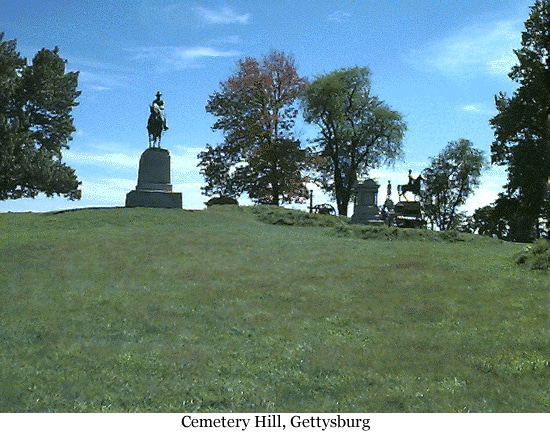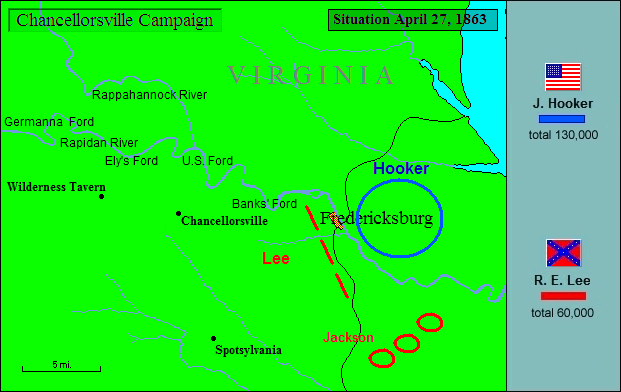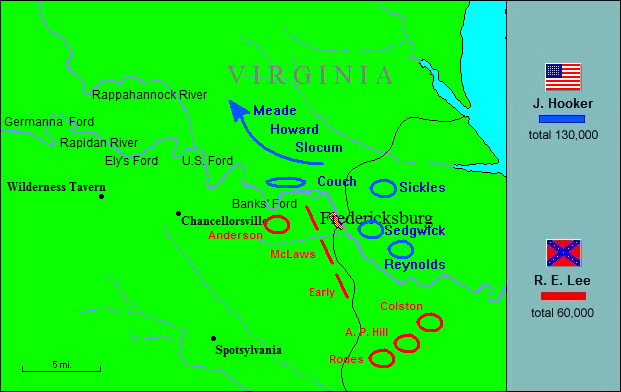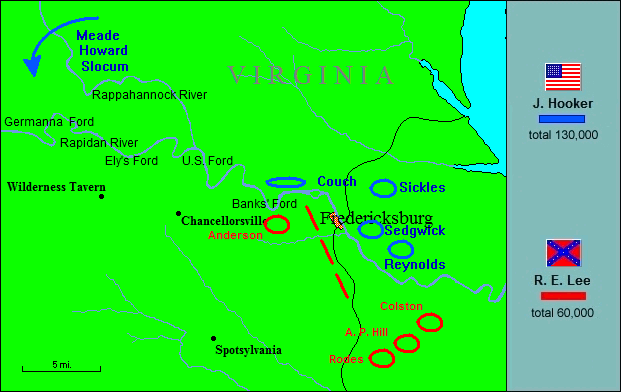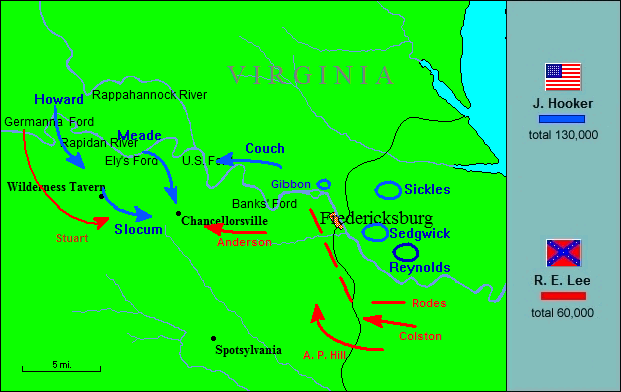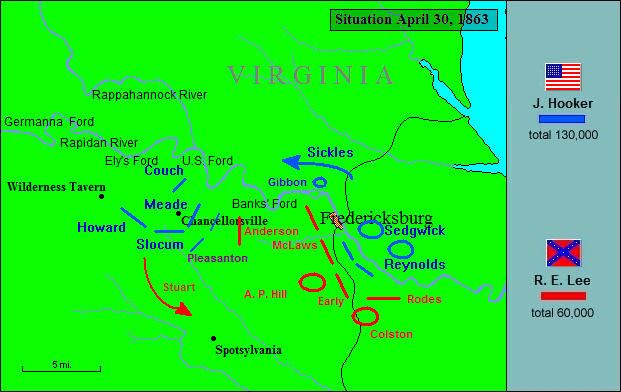From Chancellorsville to Chattanooga
Mine eyes have seen the glory of the coming of the Lord:
He is trampling out the vintage where the grapes of wrath are stored;
He hath loosed the fateful lightning of His terrible swift sword:
His truth is marching on.
–from Battle Hymn of the Republic, by William Steffe
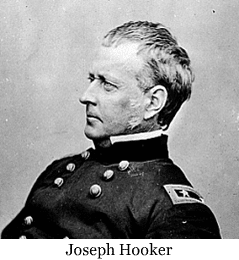
Looking at the situation as Lincoln saw it in the spring of 1863 when Grant had yet to cross the river gives a more complicated picture. Grant had already struck one blow at Vicksburg, Sherman’s bloody repulse at Chickasaw Bluffs at the close of ’62, and since then he had been ditching, dredging, and marching all over the countryside without making any discoverable progress. Even if Vicksburg were to fall immediately, there remained Bragg’s army down in Tullahoma, Tennessee. Rosecrans was still stalled to the northeast at Murfreesboro, and who could tell if he would ever get closer to Chattanooga than Buell had before him. In the East of course there was always Marse Robert and the army that Southerners had learned to call Lee’s Invincibles. Except for the trick of fate that had tripped him up on Antietam Creek, he had driven McClellan off the Peninsula, routed Pope at Second Bull Run, and crushed Burnside at Fredericksburg. Like that other great Virginian before him, George Washington, it was still possible for him to win by not losing, until the will of a more powerful foe was exhausted.
The problem for the Confederacy, however, was that its powerful foe, despite its defeats, was growing more so. Although thousands of former farm boys and factory hands were now under arms, a great wave of immigrants took up their work. A thousand immigrants a day came into New York City alone. It is worth noting that in the midst of civil war the Homestead Act of 1862 would open the Great Plains to thousands of settlers. Industry and agriculture both enjoyed explosive growth in the North, while the Southern economy was already buckling under the strain of war and blockade. The Lincoln government was in a position to do what Lincoln had wanted from the beginning: to stretch Confederate strength until it snapped somewhere. Banks and Farragut were in operation in southern Louisiana; Grant was working his way toward Vicksburg; Rosecrans was just up the railroad from Chattanooga. Now in the spring, the Federals were making a thrust south of the James River, threatening the Norfolk area and the North Carolina coast. So urgent was Lee’s need to keep food and forage coming from that region that he was forced to detach Longstreet and two divisions and send them there to check a possible Federal advance. Now if Lincoln could find a general who could close with Robert E. Lee in Virginia and whip him, the beginning of the end of the Confederacy might be at hand.
Lincoln called this time on Joe Hooker, and as far as Fighting Joe was concerned, the president could not have made a wiser choice. “May God have mercy on General Lee,” he boasted, “for I will have none,” perhaps forgetting the fate that had befallen another braggart back at Second Bull Run. He was arguably as wise a choice as Lincoln might have made at the moment. Although Hooker was hard-drinking, profane, and considered scandalous by some for his commerce with the ladies, he had a good combat record. His corps had fought well in the Seven Days and in that savage encounter with Jackson’s corps in the Cornfield at Antietam. He was, it was true, something of an intriguer within the officer corps, and what he had to say about Ambrose Burnside behind his back had done neither the general nor his army’s morale any good. He had even gone so far as to suggest that the national crisis required a dictator’s sure hand. Lincoln, an exceedingly canny intriguer himself, was well aware of Hooker’s unguarded opinions. To him he wrote: “General: I have placed you at the head of the Army of the Potomac…. I have heard, in such a way as to believe it, of your recently saying that both the Army and the Government needed a dictator. Of course, it was not for this, but in spite of it, that I have given you the command. Only those generals who gain successes can set up dictators. What I now ask of you is military success, and I will risk the dictatorship… And now beware of rashness. Beware of rashness, but with energy, and sleepless vigilance, go forward, and give us victories.” Hooker professed to be pleased with the letter, finding it just the sort of letter a wise father might send an errant son.
What Hooker had done thus far since assuming command after Burnside’s demoralizing Mud March had been all to the good and shown energy and industry. While Lee’s men gathered sassafras buttons and wild onions to check scurvy, Hooker’s men had meat, real bread, and vegetables. He restored order and discipline to the camps. He introduced corps badges as a mark of unit pride. He reorganized his cavalry into a single corps, and when the campaign opened, they would be better-armed and better-mounted than Jeb Stuart’s troopers. In sum, Hooker thought his army “the finest body of soldiers the sun ever shone on.” The men in the ranks believed in their commander, and bluff-talking Joe Hooker certainly sounded like he believed in himself. Only Lincoln was uneasy. He had already heard too many generals speak blithely of what they would do when they got to Richmond. “The hen is the wisest of all the animal creation,” he thought, “because she never cackles until after the egg is laid.”
Hooker’s plan for the spring campaign was actually a reiteration of the Burnside plan that icy rain had turned into the sodden farce known as the Mud March. Seeing the futility of trying to hurt Lee by a head-on assault at Fredericksburg, Hooker would hold Lee’s front there with three corps. Then another three corps, screened by cavalry, would march upriver, ford the Rappahannock and Rapidan twenty-five miles to the northwest, and come down on Lee’s flank, forcing him out of his trenches for a decisive stand-up fight. Finally, one corps would follow to support and exploit any success. It was a perfectly good plan and never were the odds better for a Union success. In and around Falmouth on the east bank of the Rappahannock, Hooker’s army numbered 115,000 men of all arms, fit, well-fed, and well-equipped. With Longstreet’s two divisions detached south of the James, Lee’s army across the water at Fredericksburg reported barely 60,000 effectives and these had not wintered especially well. It was possible now to smash Lee up between the hammer falling from the west and the anvil at Fredericksburg.
Hooker’s first move was an attempt to take advantage of his superiority in cavalry strength. He sent George Stoneman with 10,000 troopers and some horse artillery thirty miles up the Rappahannock. His orders were to cross at dawn on April 13 and go slicing down on the line of supply and communication in Lee’s rear. On that morning, however, it began to rain and to rain in earnest. Stoneman, fearing for his guns and wagons in the mud, delayed until the 15th while the continuing rain washed the bottom out of Virginia’s red clay roads, and finally just stalled in the neighborhood of Rappahannock Bridge. Those who remembered the Mud March might have seen an evil omen in this deluge. Joe Hooker’s confidence, however, was not dampened by the downpour. “My plans are perfect,” he said. On the 26th (about the same time Grant was preparing to cross the Mississippi) Hooker set about putting his plans into action. He ordered the corps of Henry Slocum, George G. Meade, and Oliver Howard upriver to Kelly’s Ford where they were to cross the Rappahannock on the 28th and head for the Ely’s and Germanna fords on the Rapidan, a tributary to the south. Once over the Rapidan, they would hustle south for the Orange Turnpike, then turn east toward Chancellorsville, a bit of a crossroads village in a vast stretch of tangled second-growth forest known locally as the Wilderness. The next day Darius Couch would take his corps (less one division at Falmouth) just upriver to Banks Ford, and as soon as Slocum’s advance flanked the Rebels defending the ford out of the way, he, too, was to cross on pontoons and join the push eastward. At Falmouth the corps of Dan Sickles, John Reynolds, and John Sedgwick would cross to the Fredericksburg side just south of the city on the 29th, demonstrating against the works there. Finally, Stoneman, unstuck from the mud by now, would ride south and east to strike at the railroads in Lee’s rear.
As rarely happens in war, Hooker’s plans were executed very nearly precisely as he intended. (Couch had been forced to cross at the United States Ford farther up.) He had in fact improved his plans even as they unfolded. With the main effort to be made from the west, he called for Sickles’ corps to come from Falmouth as well to give more weight to the smashing blow he hoped to make. By noon on May Day, he had more than 70,000 men advancing in line three miles east of Chancellorsville. It was just nine miles more to the back door of Fredericksburg, where Reynolds and Sedgwick’s 40,000 were ready to hammer on the front door. “Our enemy must either ingloriously fly,” Hooker crowed, “or come out from behind his defenses and give us battle upon our own ground, where certain destruction awaits him.” Even irascible George Meade allowed himself a rare exuberant moment: “Hurrah for Old Joe!” he told Slocum. “We are on Lee’s flank and he doesn’t know it.” Lee, however, was quite clear about where the two wings of the Federal army were, and he now coolly appraised the fix he was in. Unwilling to ingloriously fly, he decided to do just as Hooker said: come out and give battle. Leaving 10,000 troops in the Fredericksburg lines under tough and determined Jubal Early, Lee hurried west up the Plank Road toward Chancellorsville with 45,000 men to confront the threat there. By midday on May 1, Lee’s advance was just west of Tabernacle Church and Hooker’s advance was just east of Chancellorsville. Between the village and the church blue and grey skirmishers began to exchange rifle fire.
What happened next is difficult to understand. Up to this point, Hooker had managed his affairs with a high degree of competence. He had five corps ready to strike a force roughly half his size. In an hour or so Sedgwick would begin a serious demonstration back in Fredericksburg. If an opportunity arose, he might even crack the line there and drive Early westward. With Meade leading the way on the left down the Orange Turnpike and River Road and Slocum on the right down the Plank Road, Hooker was very nearly out of the dense thickets of the Wilderness and into the clearings north and south of Tabernacle Church. Here he would have room to maneuver his army and exert its full weight. However, just as Meade’s lead division–it was George Sykes’–reached the eastern edge of the Wilderness, it ran into the main battle line of Lee’s right posted on high ground and began to take a beating. Sykes was flanked on both ends and had to fall back, calling for help. Even so, no harm really had been done thus far. Couch’s corps was coming up in support, and Winfield Scott Hancock’s lead division was already at hand and on the way. Farther left, on the River Road Meade’s other two divisions were advancing and had yet to run into Rebels. On the right Slocum had engaged Lee’s main line and all was well there. Hooker’s next order, therefore, astonished them all: it was to withdraw and fall back on Chancellorsville. After less than three hours of fighting in which his advance was off to a promising start, Hooker decided to go on the defensive back in the forbidding jungles around Chancellorsville. He drew up his corps in a long curving line and dug in, his left on a loop of the Rappahannock just downstream from United States Ford, his right in the air near Wilderness Church on the Orange Turnpike.
What possessed Joe Hooker that day has been the subject of much speculation, then as now. For one thing, Rebel deserters–real or merely shills–reported John B. Hood’s division on the way. For another, intelligence from Falmouth reported to him that Longstreet’s whole corps was on its way to Culpeper in his rear. Neither report was true, but it may be that, like McClellan before him, Hooker was now struggling with phantom Rebels. Then, too, it may have been that Fighting Joe just needed a stiff drink. He’d been on the wagon since taking command three months before. Finally, though, Hooker’s improbable decision was most likely about character. An old army friend of Hooker’s remembered Hooker as a shrewd poker player until the moment of a high-stakes’ crisis: “Hooker could play the best game of poker I ever saw until it came to a point where he should go a thousand better, and then he would flunk.” As in tragedy, fate is not in our stars but in ourselves. Joe Hooker perhaps put it best: “I just lost confidence in Joe Hooker.” Darius Couch saw him that evening and privately pronounced him a “whipped man.”
Hooker was still talking a good fight, however. He assured Couch that “I’ve got Lee right where I want him,” insisting that Lee’s army was now “the legitimate property of the Army of the Potomac.” Bluster notwithstanding, Hooker had, for one thing, backed himself into the Wilderness, and, more dangerous, he had surrendered the initiative to Robert E. Lee. Every general who had done so thus far had come to grief.

